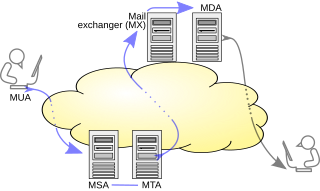
Electronic mail is a method of transmitting and receiving messages using electronic devices. It was conceived in the late–20th century as the digital version of, or counterpart to, mail. Email is a ubiquitous and very widely used communication medium; in current use, an email address is often treated as a basic and necessary part of many processes in business, commerce, government, education, entertainment, and other spheres of daily life in most countries.
In computing, the Internet Message Access Protocol (IMAP) is an Internet standard protocol used by email clients to retrieve email messages from a mail server over a TCP/IP connection. IMAP is defined by RFC 9051.
The Simple Mail Transfer Protocol (SMTP) is an Internet standard communication protocol for electronic mail transmission. Mail servers and other message transfer agents use SMTP to send and receive mail messages. User-level email clients typically use SMTP only for sending messages to a mail server for relaying, and typically submit outgoing email to the mail server on port 587 or 465 per RFC 8314. For retrieving messages, IMAP is standard, but proprietary servers also often implement proprietary protocols, e.g., Exchange ActiveSync.

An email client, email reader or, more formally, message user agent (MUA) or mail user agent is a computer program used to access and manage a user's email.
A message delivery agent (MDA), or mail delivery agent, is a computer software component that is responsible for the delivery of e-mail messages to a local recipient's mailbox. It is also called a local delivery agent (LDA).
An email address identifies an email box to which messages are delivered. While early messaging systems used a variety of formats for addressing, today, email addresses follow a set of specific rules originally standardized by the Internet Engineering Task Force (IETF) in the 1980s, and updated by RFC 5322 and 6854. The term email address in this article refers to just the addr-spec in Section 3.4 of RFC 5322. The RFC defines address more broadly as either a mailbox or group. A mailbox value can be either a name-addr, which contains a display-name and addr-spec, or the more common addr-spec alone.
Various anti-spam techniques are used to prevent email spam.
Greylisting is a method of defending e-mail users against spam. A mail transfer agent (MTA) using greylisting will "temporarily reject" any email from a sender it does not recognize. If the mail is legitimate, the originating server will try again after a delay, and if sufficient time has elapsed, the email will be accepted.
A bounce message or just "bounce" is an automated message from an email system, informing the sender of a previous message that the message has not been delivered. The original message is said to have "bounced".
In email, a return receipt is an acknowledgment by the recipient's email client to the sender of receipt of an email message. What acknowledgment, if any, is sent by the recipient to the sender is dependent on the email software of the recipient.
Email authentication, or validation, is a collection of techniques aimed at providing verifiable information about the origin of email messages by validating the domain ownership of any message transfer agents (MTA) who participated in transferring and possibly modifying a message.

A message submission agent (MSA), or mail submission agent, is a computer program or software agent that receives electronic mail messages from a mail user agent (MUA) and cooperates with a mail transfer agent (MTA) for delivery of the mail. It uses ESMTP, a variant of the Simple Mail Transfer Protocol (SMTP), as specified in RFC 6409.
The Sender Rewriting Scheme (SRS) is a scheme for bypassing the Sender Policy Framework's (SPF) methods of preventing forged sender addresses. Forging a sender address is also known as email spoofing.
Sieve is a programming language that can be used for email filtering. It owes its creation to the CMU Cyrus Project, creators of Cyrus IMAP server.
Email forwarding generically refers to the operation of re-sending a previously delivered email to an email address to one or more different email addresses.
A mailbox is the destination to which electronic mail messages are delivered. It is the equivalent of a letter box in the postal system.
Backscatter is incorrectly automated bounce messages sent by mail servers, typically as a side effect of incoming spam.
A bounce address is an email address to which bounce messages are delivered. There are many variants of the name, none of them used universally, including return path, reverse path, envelope from, envelope sender, MAIL FROM, 5321-FROM, return address, From_, Errors-to, etc. It is not uncommon for a single document to use several of these names.

An e-mail agent is a program that is part of the e-mail infrastructure, from composition by sender, to transfer across the network, to viewing by recipient. The best-known are message user agents and message transfer agents, but finer divisions exist.
SMTP Authentication, often abbreviated SMTP AUTH, is an extension of the Simple Mail Transfer Protocol (SMTP) whereby a client may log in using any authentication mechanism supported by the server. It is mainly used by submission servers, where authentication is mandatory.




